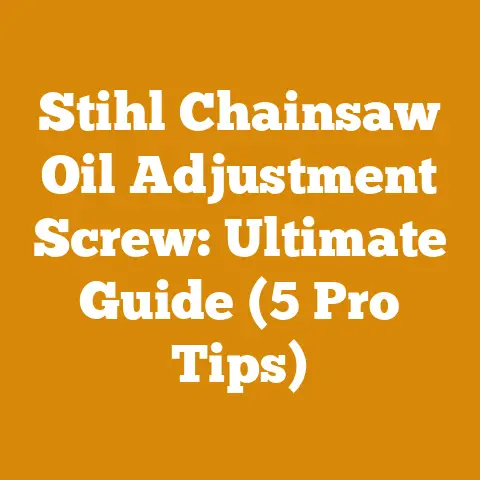Husqvarna Technical Forest Helmet (5 Pro Tips for Better Safety)
Husqvarna Technical Forest Helmet: 5 Pro Tips for Better Safety
Did you know that head injuries account for approximately 15% of all logging-related injuries, and are responsible for a disproportionately high percentage of fatal accidents? This stark statistic underscores the crucial importance of wearing proper head protection when working in the forest.
This blog post delves into the Husqvarna Technical Forest Helmet, highlighting its features and, more importantly, providing you with 5 pro tips to maximize its safety benefits. Whether you’re a seasoned professional or a weekend warrior tackling some tree trimming, understanding how to properly use and maintain this helmet can significantly reduce your risk of injury.
What Makes the Husqvarna Technical Forest Helmet Special?
The Husqvarna Technical Forest Helmet is designed specifically for the rigors of forestry work. Here’s a quick rundown of its key features:
- Robust Shell: Constructed from durable materials (typically ABS plastic), the shell is designed to withstand impacts from falling branches, debris, and other hazards.
- Adjustable Harness: A comfortable and adjustable harness ensures a secure and personalized fit. This is crucial for keeping the helmet in place during strenuous activity.
- Integrated Ear Protection: Many models come with integrated ear muffs offering effective noise reduction, protecting your hearing from the damaging sounds of chainsaws and other machinery.
- Mesh Visor: The mesh visor provides excellent visibility while shielding your face from flying debris like wood chips and sawdust.
- Ventilation: Strategically placed vents help to keep your head cool and comfortable, even during demanding tasks.
- Universal Fit: Designed to accommodate a wide range of head sizes.
While the helmet itself is a valuable piece of safety equipment, its effectiveness hinges on proper usage and maintenance. Let’s dive into those crucial pro tips.
5 Pro Tips for Better Safety with Your Husqvarna Technical Forest Helmet:
1. The Perfect Fit: Adjust, Adjust, Adjust!
This is arguably the most important tip. A helmet that’s too loose or too tight won’t provide adequate protection.
- Measuring Your Head: Before you even buy the helmet, measure your head circumference just above your eyebrows. Consult the Husqvarna size chart to ensure you choose the correct size.
- Harness Adjustment: The harness should fit snugly but comfortably. Use the adjustment knob or straps to tighten or loosen the harness until the helmet sits securely on your head. It should not wobble or shift excessively when you move your head.
- Chin Strap: The chin strap is critical for keeping the helmet in place during impact. Adjust it so that it sits comfortably under your chin, allowing you to speak and breathe easily. You should be able to fit one or two fingers between the strap and your chin.
- The “Shake Test”: Once you’ve adjusted the harness and chin strap, perform the “shake test.” Shake your head vigorously from side to side and up and down. If the helmet shifts significantly, readjust the harness and chin strap until it stays firmly in place.
Why is this important? A loose helmet can come off during a fall or impact, leaving you completely unprotected. A too-tight helmet can be uncomfortable and distracting, potentially leading to decreased focus and increased risk of accidents.
2. Visor Awareness: Choose the Right Visor and Keep it Clean.
The visor is your first line of defense against flying debris. Selecting the correct visor for the task and maintaining its cleanliness are crucial for optimal safety and visibility.
- Visor Options: Husqvarna offers different visor options, including mesh, clear polycarbonate, and tinted visors. Choose the visor that best suits the conditions and the type of work you’re doing. Mesh visors are great for general forestry work, while clear or tinted visors are ideal for tasks requiring enhanced visibility in specific lighting conditions.
- Regular Cleaning: A dirty visor can significantly impair your vision, increasing the risk of accidents. Clean your visor regularly with a mild soap and water solution. Avoid using harsh chemicals or abrasive cleaners that can damage the visor’s surface.
- Visor Inspection: Before each use, inspect the visor for cracks, scratches, or other damage. A damaged visor should be replaced immediately.
- Consider a Full-Face Visor: For tasks involving a high risk of facial injury, consider using a full-face visor for maximum protection.
Why is this important? Impaired vision is a major contributor to accidents in forestry work. A clean, undamaged visor ensures you have a clear view of your surroundings, allowing you to react quickly to potential hazards.
3. Ear Protection Matters: Don’t Neglect Your Hearing.
Chainsaws and other forestry equipment produce high levels of noise that can cause permanent hearing damage. The integrated ear muffs on many Husqvarna Technical Forest Helmets provide valuable hearing protection.
- Proper Fit is Key: Ensure the ear muffs fit snugly over your ears, creating a tight seal. Adjust the headband to achieve a comfortable and secure fit.
- Noise Reduction Rating (NRR): Pay attention to the NRR of the ear muffs. A higher NRR indicates better noise reduction. Choose ear muffs with an NRR that is appropriate for the noise levels you’ll be exposed to.
- Inspect for Damage: Regularly inspect the ear muffs for cracks, tears, or other damage. Damaged ear muffs should be replaced.
- Consider Supplemental Ear Protection: For extremely noisy environments, consider using supplemental ear protection, such as earplugs, in addition to the integrated ear muffs.
Why is this important? Noise-induced hearing loss is a serious and irreversible condition. Protecting your hearing is essential for your long-term health and well-being.
4. Helmet Lifespan: Know When to Replace Your Helmet.
Even with proper care, your helmet won’t last forever. The materials degrade over time, and the helmet’s ability to absorb impact diminishes.
- Follow Manufacturer’s Recommendations: Husqvarna typically recommends replacing the helmet every 3-5 years, regardless of its condition. Consult the owner’s manual for specific recommendations.
- Replace After Impact: If your helmet sustains an impact, even if there’s no visible damage, it should be replaced immediately. The impact may have compromised the helmet’s structure, making it less effective in future impacts.
- Inspect Regularly: Regularly inspect the helmet for cracks, dents, fading, or other signs of wear and tear. If you notice any significant damage, replace the helmet.
- Storage Matters: Store your helmet in a cool, dry place away from direct sunlight and extreme temperatures. This will help to prolong its lifespan.
Why is this important? A damaged or degraded helmet may not provide adequate protection in the event of an accident. Replacing your helmet regularly ensures that you’re always wearing a helmet that’s in optimal condition.
5. Beyond the Helmet: Complementary Safety Gear.
- Eye Protection: Even with a visor, wearing safety glasses or goggles can provide an extra layer of protection against small debris.
- Protective Clothing: Wear appropriate protective clothing, such as chainsaw chaps, cut-resistant gloves, and sturdy boots.
- First Aid Kit: Keep a well-stocked first aid kit readily available in case of injury.
- Communication: Ensure you have a reliable means of communication in case of an emergency.
- Training: Proper training in chainsaw operation and other forestry tasks is essential for safe work practices.
Why is this important? A holistic approach to safety is crucial for minimizing your risk of injury. Combining the Husqvarna Technical Forest Helmet with other appropriate safety gear and proper training will significantly enhance your safety in the forest.
Conclusion:
The Husqvarna Technical Forest Helmet is a valuable tool for protecting your head while working in the forest. By following these 5 pro tips, you can maximize its safety benefits and significantly reduce your risk of head injuries. Remember, your safety is paramount. Invest in quality protective gear, use it properly, and always prioritize safety in the forest. Stay safe out there!






